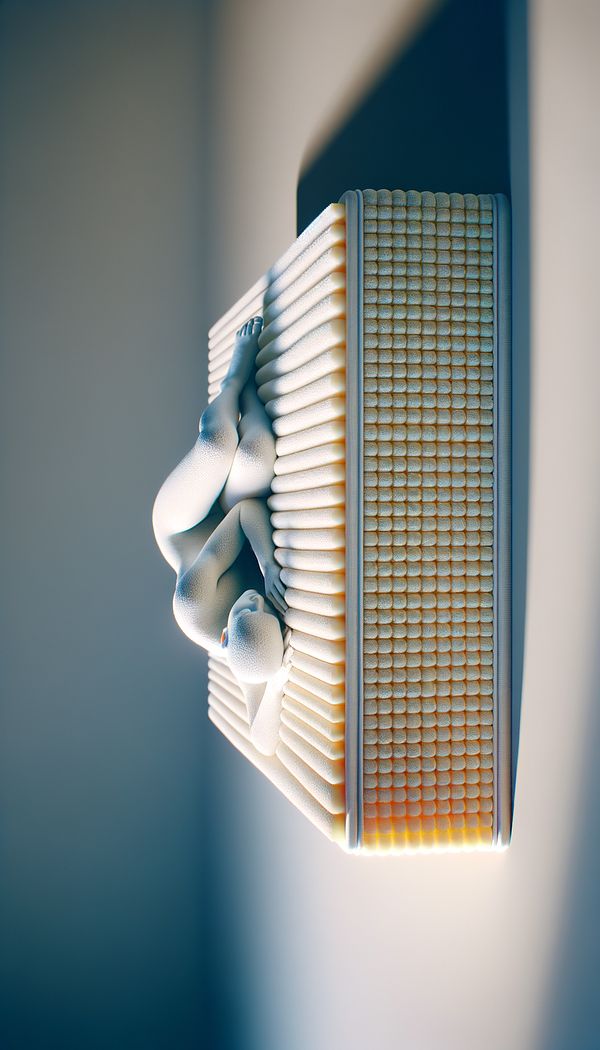What is Viscoelastic Foam?
Viscoelastic foam is a type of polyurethane foam known for its ability to mold to the body in response to heat and pressure.
Description
Viscoelastic foam, commonly known as memory foam, is a distinctive material widely celebrated in the interior design and furniture industry for its unique properties. Developed initially by NASA in the 1960s to improve the safety of aircraft cushions, this material has transitioned into the consumer market, predominantly within the comfort and ergonomics sectors. Viscoelastic foam is notable for its ability to conform to the shape of an individual's body, offering unparalleled support and comfort by evenly distributing body weight and reducing pressure points. This characteristic is due to its open-cell structure, which reacts to body heat and pressure by molding to the body's contours before returning to its original shape once the pressure is removed.
The adaptive qualities of viscoelastic foam make it an ideal choice for various applications within interior design, especially in the manufacturing of mattresses, pillows, and upholstered furniture. Its use extends to providing ergonomic solutions in seating and support products, enhancing the accessibility and ergonomics of living spaces. Furthermore, viscoelastic foam can also be found in the design of specialized products aimed at improving sleep quality and relieving pain.
In addition to its comfort and ergonomic benefits, viscoelastic foam also possesses hypoallergenic properties, making it suitable for use in environments sensitive to allergens and dust mites. However, it's essential to be aware of the foam's density and quality, as these factors can significantly affect its durability and comfort level.
Usage
Viscoelastic foam is widely used in the design and manufacturing of comfort-oriented furniture and products. Its applications include mattresses, mattress toppers, pillows, and upholstery for chairs and sofas, offering enhanced comfort and support. Additionally, viscoelastic foam is utilized in specialized products aimed at improving health and well-being, such as ergonomic seating cushions and products designed for pain relief.
FAQs
-
How does viscoelastic foam differ from regular foam?
Viscoelastic foam differs from regular foam in its unique ability to conform closely to body shapes in response to body heat and pressure. This allows for even weight distribution and reduced pressure points, unlike traditional foam which may not mold as effectively to the body.
-
Can viscoelastic foam improve sleep quality?
Yes, due to its ability to provide tailored support by molding to the body's shape, viscoelastic foam can significantly improve sleep quality. It minimizes pressure points and allows for a more comfortable sleeping posture, which can lead to better sleep.
-
Is viscoelastic foam suitable for people with allergies?
Yes, viscoelastic foam is hypoallergenic and resistant to dust mites, making it a suitable option for people with allergies or sensitivities.
Practical Application
When considering viscoelastic foam for your interior design projects, pay close attention to the foam's density and quality. These factors can greatly influence the product's durability and overall comfort. Testing the material firsthand can also provide valuable insights into its suitability for specific applications. Additionally, integrating viscoelastic foam into furniture or products catering to comfort and ergonomics can significantly enhance the living environment's accessibility and overall well-being.
-
Furniture Types599 articles
-
Decorating Principles & Elements330 articles
-
Materials & Textiles360 articles
-
Accessibility & Ergonomics30 articles
-
Construction & Building86 articles
-
FauxFaux refers to artificial or imitation materials and finishes designed to mimic the appearance of natural or more expensive materials.
-
Reclaimed WoodReclaimed wood is recycled wood that has been repurposed for new uses.
-
Spanish RenaissanceSpanish Renaissance refers to a period and style in interior design characterized by ornate decorations, rich colors, and intricate details.
-
GueridonA Gueridon is a small, often round, stand or table.
-
Sleepy Hollow ChairA Sleepy Hollow chair is a distinct type of armchair known for its comfort and unique design.
